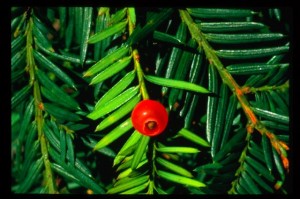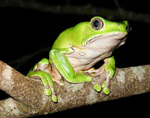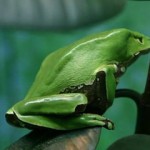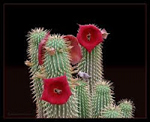Biopiracy Leaves Native Groups Out in the Cold | Cazadores de la medicina perdida
By Humberto Márquez
IPS
English | Spanish
CARACAS – Millions of cancer patients around the world benefit from a medication called Paclitaxel (Taxol), which may begin to be produced from a new source: fungi found at the summit of Venezuela’s flat-topped mountains. But the indigenous communities who have lived in that area since time immemorial will receive no benefits, and were not even consulted on the matter.
In another case, researchers at the Federal Institute of Technology (ETH) in Zurich, after signing an agreement with the Venezuelan government in 1998, began to do field work early this decade among Yanomami communities in the extreme southern part of this South American country.
They studied and collected medicinal plants used by the Yanomami, an Amazon jungle people, as well as learning from their strategies of managing these natural resources.
“Our countries are highly vulnerable to biopiracy, to what is practically an invasion by global pharmaceutical companies,”
Julio César Centeno, a forestry specialist at the University of Los Andes in Venezuela, told IPS.
“They evade international agreements and take advantage of the weak monitoring of biodiversity in our country.”
María Elisa Febres, a lawyer for the Vitales environmental organisation, told IPS that
“continued efforts to bring this issue to light and to pursue cases in the Andean and Amazon regions has helped bring about progress, like the adoption of the Nagoya Protocol, last October [2010].”
The protocol adopted in the Japanese city of Nagoya is aimed at managing access to the natural genetic resources from plants and animals and the sharing of benefits derived by pharmaceutical and cosmetic companies from the use of such resources with the developing nations and indigenous communities where they are found.
Vitalis has documented the case of Taxol, the commercial name under which the New York-based Bristol Myers Squibb registered Paclitaxel, a chemotherapy drug used to treat breast cancer, ovarian cancer, lung cancer, head and neck cancer, bladder cancer, and AIDS-related Kaposi’s sarcoma.
It is also potentially useful to treat psoriasis, congenital polycystic kidney disease, multiple sclerosis and Alzheimer’s disease.
By 2000, Bristol’s annual sales of Taxol amounted to nearly 1.6 billion dollars, and by 2003 the drug had been used to treat one million patients.
Paclitaxel was originally extracted from the bark of the Pacific yew tree (Taxus brevifolia), native to the northwest coastal region of the U.S.
But it is a small, scarce, extremely slow-growing tree, and the drug’s active ingredient is concentrated in the bark, in small quantities (one gram per 14 kilos of bark). That means at least three trees must be destroyed to obtain enough Paclitaxel to treat just one patient.
For that reason, a furor began two decades ago to obtain Paclitaxel from other sources: first, other trees of the genus Taxus, and later from fungi that could be produced more easily and at a lower cost, using biotechnology, said Gary Strobel, a plant biologist at Montana State University.
Strobel visited remote areas on four continents, and found Paclitaxel in organisms present in plants in Australia, Nepal and Venezuela.
In Venezuela, he discovered it in Stegolerium kukenani and Seimatoantlerium tepuiense, fungi that grow on plants found at the top of the Kukenán and Roraima tepuis, table-top mountains or mesas in the highlands area straddling the borders of Venezuela, Brazil and Guyana.
He also found the Serratia marcescens bacterium, capable of producing Oocydin A, tested as an anti-cancer agent.
The area where the researchers extracted plant samples, without informing or receiving permission from local communities, is the 30,000 square km Canaima National Park best known for the ancient flat-topped, steep-sided tepuis, which harbour ecosystems composed of unique plant and animal species. The park is home to some 30,000 Pemón indigenous people.
Years ago, Strobel informed Vitalis that he had tried and failed to contact authorities in the countries he visited, and that he collected samples in Venezuela in 1998. He also said that at one point when he was at the summit of a tepui, he didn’t know if he was in Brazil, Guyana or Venezuela.
Ferrer pointed out that Strobel’s research has given rise, in the United States, to some 50 patents for Montana State University in association with pharmaceutical giants like Bristol Myers Squibb and Cytoclonal Pharmaceutics, and that some of the patents broadly cover
“microorganisms from any source”
that are capable of producing Paclitaxel.
In the case of the Yanomami, perhaps the most ancient living tribe in Latin America, who apparently have lived in the area that is today southern Venezuela and northern Brazil for 25,000 years or more, Centeno pointed out that the agreement between the Federal Institute of Technology in Zurich and the Venezuelan government allowed eight Swiss researchers to study the Amerindian group’s medicinal plants and practices.
“But it turns out that according to the Yanomami, when someone falls ill, they don’t make medicine as we know it in the West, but use magic or spiritual rites that the academic world does not recognise, because it only works with substances and procedures that have effects that can be proven and experimentally repeated,”
the forestry expert said.
Anthropologist Daniel de Barandiarán, in his classic text “Children of the Moon”, showed how the Yanomami shaman “heals” by restoring the patient’s relations with the “hikolas” or spirits of plants and animals.
Centeno said
“The knowledge collected among the Yanomami — which New Tribes missionaries from the U.S. did for years — and substances gathered in the areas where they live is presented, in Zurich for example, as a discovery that brings prestige and money to beneficiaries in Europe.”
He said researchers from universities in Venezuela have also carried out studies on plants and indigenous knowledge among communities like the Yanomami
“under the argument, perhaps plausible, that this information should be compiled before it is lost due to the shrinking of their territory or of the native groups themselves.”
But, he stressed,
“we should set an example by consulting the indigenous communities that live in Venezuela’s border areas, allowing them to participate, and we must share the benefits with these people who live in a state of such great material need.”
Source: IPS
Por Humberto Márquez
IPS
español | inglés
CARACAS – Millones de enfermos de cáncer en el mundo podrán beneficiarse del medicamento taxol (paclitaxel), elaborado por laboratorios de Estados Unidos a partir de hongos como los de las montañas tepuy de Venezuela, sin retribuir nada a las comunidades indígenas que habitan esos paisajes desde tiempo inmemorial.
En otro caso, investigadores de la Universidad Federal de Zurich, tras un acuerdo con el gobierno venezolano en 1998, penetraron a comienzos de esta década en las comunidades yanomami, en el extremo sur de este país sudamericano, para extraer plantas medicinales de esos habitantes de la Amazonia, así como sus estrategias de manejo de tales recursos.
“Nuestros países son muy vulnerables a la biopiratería, a lo que es prácticamente una invasión de las compañías farmacéuticas globales. Se soslayan acuerdos internacionales y se aprovechan de la débil vigilancia sobre nuestra biodiversidad”,
apuntó a IPS el investigador forestal Julio César Centeno, de la venezolana Universidad de Los Andes.
Aún así
“insistir en señalar y trabajar casos en las regiones andina y amazónica contribuye a progresos como la adopción, en octubre [2010], del Protocolo de Nagoya”,
destacó a IPS María Elisa Febres, abogada de la organización no gubernamental ambientalista Vitalis.
El Protocolo adoptado en esa ciudad japonesa norma el acceso a recursos genéticos, pauta la consulta a las comunidades concernidas y señala que los beneficios obtenidos por empresas farmacéuticas y cosméticas del uso de animales, plantas y microorganismos se compartan con los países donde se extraen esos recursos.
Vitalis documentó el caso del taxol, nombre comercial, registrado por la corporación Bristol Myers Squibb, del paclitaxel, agente indicado para el cáncer de mama, ovario, pulmón y sarcoma de Kaposi, y probablemente útil frente a la psoriasis, la enfermedad renal poliquística, la esclerosis múltiple y el mal de Alzheimer.
Ya en 2003 el taxol pasó el umbral de un millón de pacientes tratados y alcanza ventas en promedio superiores a los 1.000 millones de dólares anuales, por lo que comienza a hacerle frente a la competencia de genéricos.
El paclitaxel se obtuvo primeramente del árbol Tejo del Pacífico (Taxus brevifolia), propio de la costa oeste estadounidense. Pero es un árbol pequeño, escaso, de lento crecimiento, y el principio activo del fármaco se concentra en la corteza del tronco, por lo que para extraer la materia prima se debe dañar irreparablemente la planta.
Se obtienen generalmente tres miligramos de agente anticancerígeno por kilogramo de corteza, por lo que es necesario destruir tres árboles (27 kilogramos de corteza) para extraer la dosis que requiere el tratamiento de un solo paciente.
Por ello, desde hace dos décadas comenzó una “furia” por obtener paclitaxel primero de otros árboles del género taxus, y luego en hongos que
“pudieran ser reproducidos más fácilmente y a menor costo, utilizando las capacidades de la industria de la biotecnología”,
indicó Gary Strobel, de la estadounidense Universidad de Montana.
Strobel visitó parajes remotos en cuatro continentes y constató la producción de paclitaxel en organismos presentes en plantas de Australia, Nepal y Venezuela.
En este último caso se trata de los hongos Stegolerium kukenani y Seimatoantlerium tepuiense, que crecen sobre plantas presentes en las cimas de los tepuyes Kukenán y Roraima, fronterizos entre Brasil, Guyana y Venezuela. También la bacteria Serratia marcescens, capaz de producir el anticancerígeno Oocydina A.
El área donde fueron extraídos estos organismos, sin permiso o consulta alguna a los involucrados, es el Parque Nacional Canaima, de 30.000 kilómetros cuadrados y asiento de los tepuyes, montañas antiquísimas de paredes verticales y cumbres casi planas. Es hábitat de la etnia indígena pemón, de unos 30.000 individuos.
Strobel informó hace años a Vitalis que trató “sin éxito” de contactar autoridades de los países donde estuvo, que colectó muestras en Venezuela en 1998 y que en algún momento en la cima de los tepuyes
“no sabía si estaba en Brasil, Guyana o Venezuela”.
Ferrer recordó que las investigaciones de Strobel han dado lugar, en Estados Unidos, a unas 50 patentes para la Universidad de Montana en asociación con laboratorios como Bristol Myers y Cytoclonal Pharmaceutics, y algunas abarcan, muy genéricamente,
“microorganismos de cualquier fuente”
capaces de producir taxol.
En el caso de los yanomami, quizá el pueblo más antiguo de América Latina, con 25.000 años o más en el sur de lo que es hoy Venezuela y el norte de Brasil, Centeno recordó que el acuerdo entre la Universidad de Zurich y el gobierno venezolano permitió a ocho científicos suizos investigar hierbas y prácticas medicinales de esos indígenas.
“Pero resulta que, según los yanomami, ante cada enfermo ellos no hacen medicina en el sentido que la conocemos en Occidente, sino magia o ritos espirituales que el mundo académico no reconoce, pues trabaja sobre sustancias y procedimientos con efectos que se puedan demostrar y repetir experimentalmente”,
observó Centeno.
Ya el antropólogo Daniel de Barandiarán, en su clásico “Los hijos de la Luna” mostró cómo el shamán yanomami “cura” restableciendo la relación afectada entre el paciente y los “híkola” o fuerzas espirituales superiores asociadas a géneros animales o vegetales.
Por esa vía,
“el saber colectado entre los yanomami –algo que por décadas hicieron evangelizadores estadounidenses de las Nuevas Tribus– y sustancias obtenidas en su hábitat pueden ser presentados, en Zurich por ejemplo, como un descubrimiento que remunere con prestigio y dinero a beneficiarios en Europa”,
apuntó Centeno.
Sostuvo que investigadores de universidades de Venezuela también han adelantado prospecciones de plantas y saberes entre comunidades como las yanomami
“con el argumento quizá plausible de recopilar la información antes de que se pierda por reducción del hábitat o del pueblo originario”.
Sin embargo,
“deberíamos dar el ejemplo con consulta, participación y beneficios compartidos con las comunidades indígenas que habitan las fronteras de Venezuela en condiciones materiales de mucha necesidad”,
agregó Centeno.
Fuente: IPS









Comments
Biopiracy Leaves Native Groups Out in the Cold | Cazadores de la medicina perdida — No Comments